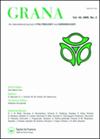大西洋森林濒危和特有凤梨科物种的花形态和花粉活力
IF 1
4区 生物学
Q4 PLANT SCIENCES
引用次数: 1
摘要
摘要本研究描述了凤梨属植物Nidularium minutum Mez的花形态,并对其花粉活力进行了评价。通过组织化学和花粉萌发试验。花序为针状头状花序,短枝上有2 - 3朵无臭的两性绿白色花,雄蕊短于雌蕊,由6个雄蕊和花药组成,花药具有裂片状。胚珠倒生,在合点区显示一个小附属物。2018年11月下旬首次开放,2019年1月为花期高峰。花期从早上6点55分开始,一直持续到8点49分。花粉/胚珠比表明兼性自交。花粉粒为单胞体,中至大,2-(3)孔,网状异苞叶,有丰富的花粉基。花粉粒大小不一致的不活花粉出现的频率很高。成熟的花粉粒被认为是顽固性的,因此对干燥敏感。48h后,BKM培养基的花粉萌发率为64.77%,高于SM(38.51%)。在所有组织化学测试中,花粉活力都被高估,亚历山大(72.46%)最接近离体发芽率。该研究结果为濒危观赏凤梨属植物的培育提供了新的生物学信息。本文章由计算机程序翻译,如有差异,请以英文原文为准。
Floral morphology and pollen viability of an endangered and endemic Bromeliaceae species from the Atlantic Forest
Abstract The present study describes the floral morphology and evaluates pollen viability for the bromeliad Nidularium minutum Mez. during the flowering period 2018‒2019 through histochemistry and pollen germination tests. The inflorescences are nidular, capituliform with short branches bearing two to three odourless, bisexual and greenish-white flowers and with an androecium shorter than the gynoecium, consisting of six stamens with anthers featuring rimose dehiscence. The ovules are anatropous, displaying a small appendage in the chalazal region. The first flower opened in late November 2018 and flowering peak was in January 2019. Anthesis started at 6:55 a.m. and lasted until 8:49 a.m. Pollen/ovule ratio indicates facultative autogamy. The pollen grains are monads, medium to large, 2-(3)-porate, reticulate heterobrochate with abundant pollenkitt. A high frequency of unviable pollen grains with discrepant sizes was observed. The mature pollen grain is considered recalcitrant and therefore sensitive to desiccation. In vitro pollen germination after 48 hours was higher in BKM medium (64.77%) compared to SM (38.51%). Pollen viability was overestimated in all histochemistry tests, with Alexander (72.46%) being the closest to the in vitro germination rate. The results obtained for N. minutum bring new information about its floral biology as a subsidy to the cultivation of ornamental bromeliads that are at risk of extinction.
求助全文
通过发布文献求助,成功后即可免费获取论文全文。
去求助
来源期刊

Grana
生物-植物科学
CiteScore
2.10
自引率
11.10%
发文量
23
审稿时长
>12 weeks
期刊介绍:
Grana is an international journal of palynology and aerobiology. It is published under the auspices of the Scandinavian Palynological Collegium (CPS) in affiliation with the International Association for Aerobiology (IAA). Grana publishes original papers, mainly on ontogony (morphology, and ultrastructure of pollen grains and spores of Eucaryota and their importance for plant taxonomy, ecology, phytogeography, paleobotany, etc.) and aerobiology. All submitted manuscripts are subject to initial appraisal by the Editors, and, if found suitable for further consideration, to peer review by independent, anonymous expert referees. All peer review is single blind and submission is online via ScholarOne Manuscripts.
 求助内容:
求助内容: 应助结果提醒方式:
应助结果提醒方式:


